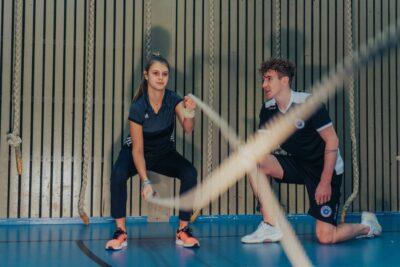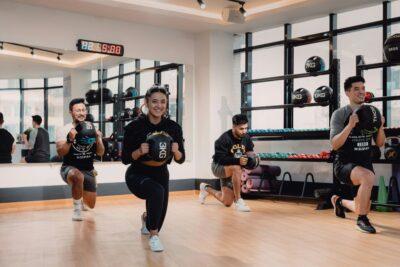Pay-per-click is one of the best marketing investments you can make. Online ads increase brand awareness by 80%. Google Ads, alongside Facebook, are two of the largest advertisers on the internet. Every second, Google processes 63,000 searches.
When it comes to fitness marketing, it’s hard to find a better marketing channel for search advertising than Google. But how do you run an effective Google Ads campaign? In this Google ads guide, we will talk you through the basics and how the Google Ads platform works so you can create a successful Google Ads campaign. Skip ahead to:
The Basics of Google Ads
When we talk about Google Ads, there’s a lot of new terminologies that pop up. So, let’s cover the basics of Google Ads first to further your understanding.
Google Ads is Google’s paid online advertising platform. It falls under the marketing channel called pay-per-click (PPC) advertising, where you, the advertiser, pay per impression on an ad. The platform initially came onto the scene back in 2000 as Google Adwords. After some rebranding, Google Ads came to fruition in 2018.
Although it can sound a bit confusing, to begin with, Google Ads can be an effective way to drive targeted traffic to your business. With Google Ads, you can boost website traffic and increase gym visits and phone calls. In the long-term, Google Ads can help you to analyze the ads you create and improve them, so you reach more suitable people.
Google Ads comes with its own glossary of terms. To get you started, here’s an introduction to some of the elements we will be discussing throughout the guide:
- Campaign – a campaign consists of one or more ad groups that all share the same budget, location, and targeting. You tend to use different campaigns to organize different products or services you offer.
- Ad Group – this contains one or more ads that all share similar goals.
- Ad – the ad is the actual ad that is displayed to your target audience.
- Keywords – these are the specific words that will trigger your ad in Google search.
- Landing page – where your visitors will go after clicking on your ad.
- Impression – the number of times your ad has been seen.
If you run Google Ads campaign before you have a complete understanding of it, you could end up wasting a lot of time and money. Here are some excellent resources that show what you should and shouldn’t be doing when it comes to PPC:
- Google Ads (AdWords) Workbook: Advertising on Google Ads, YouTube, & the Display Network – the author covers everything you need to know about the Google Ads interface as well as worksheets and video tutorials.
- How to Generate Highly Profitable Google Ads: Discover the Key Method to Explode Your Clicks and Conversions Using Google AdWords – the book takes you through a step by step guide to finding the perfect keywords and creating profitable Google Ads campaigns.
How Google Ads Work
Google Ads shows your ad to potential leads or members who are interested in services or products you have available. Advertisers bid on specific keywords or search terms. The winners of the bid are placed at the top of Google search results, YouTube, or on other relevant sites depending on the type of campaign you selected.
There are a few factors that come into play when Google is determining which ad to show. Your Ad Rank is decided by your Quality Score and your cost-per-click (CPC) bid. Your Quality score is measured by the relevancy and quality of your ad. Google measures how many people click on your ad when it’s displayed. Things like keyword relevancy, landing page user experience, ad copy, and call-to-action can all impact the relevancy and quality of your ad. The best combined CPC bid and Quality Score get the best position on Google.
Why Use Google Ads
There are so many different advertising platforms and mediums out there; it can be challenging to know what’s best for your fitness business. If you’re on the fence as to whether to start using Google Ads, here are just three reasons why you should begin today.
Range of Targeting
Google Ads can be an excellent lead generation tool and feature a range of targeting options. There’s an opportunity to target customers at any stage of the buying journey. You can bid on more broad keywords to show your ad to prospects at the earlier stages of research. Maybe they are looking for a local gym to try out.
You can then capture their information through a landing page and start sending informative content that positions your business as an authority. If they don’t convert or sign up for a trial, you can use retargeting software to draw them back in.
Google’s Massive Reach
Google is the most visited website and processes over 2.5 billion searches every day. It dominates the search engine market with a 92.18% market share. When you have a question, where do you go? The answer is probably Google. Well, so does everyone else.
Millions of people are looking for solutions, services, or products. Google has a massive reach, which means your ad has the potential to reach a large number of people. If an individual is looking for help in starting a new fitness regime and your company has the answer, they’re more likely to sign up for your services over a competitor potentially.
Suitable for Any Budget
Some businesses pay hundreds of thousands of dollars for clicks. The business services industry can be particularly costly. These highly competitive keywords can cost a whopping $58.64 a click. For 100 clicks per day, an advertiser would pay $180,000 per month for Google Ads.
But most keywords don’t cost that much. You can bring any budget to the table and find something that works for you and your fitness business. You can put a limit on your daily budget, maximum bid, and more. This way, you can stay in control of your spending and keep to your budget, whatever that may be.
7 Steps Google Ads Guide
Search advertising can supply your fitness center with a stream of potential customers at a very attractive price. To get you started, here are seven steps to take to set up a Google Ads campaign that drives more leads.
Sign Up to a Google Ads Account
To set up your first campaign, you’ll need to set up a Google Ads account. Visit the Google Ads Home page and click on the ‘Start Now’ button. Next, follow all the instructions on the screen. You can invite other users to the account to give your team direct access to Google Ads.
The Top 10 Barriers
Slowing Your Fitness
Business Growth
Discover more For expert insight and exciting topics, check out The Paid Search Podcast. The weekly podcast talks about all things Google Ads. Here are some must-listen episodes:
- Don’t Make These Common Google Ads Mistakes That We See During Audits
- How Ad Rank Works in Google Ads
- How To Get Good Results In The First Month On Google Ads
Choose a Campaign Type, Goal and Name
When you start a campaign, the first thing you’ll need to select is a goal. For the majority of businesses, the goal is to turn website traffic into leads. Other goals also include app promotion, brand awareness, leads, sales and product, and brand consideration. Remember to name your campaign. Choose a name that has something to do with the product or service your advertising.
In Google Ads, you can choose from three campaign types: search, display, or video. Search ads are the text ads that are displayed at the top of Google search engine results pages. Display ads show your ad on other websites relevant to your business. Google has an extensive array of websites that opt-in to display Google Ads, known as the Google Display Network. Finally, video ads are displayed before or after YouTube videos.
Select Ad Location
You have a few different options when it comes to location. You can choose either a large small area, a country or a city. You can also choose a really specific area. To get the ad location right, make sure you know who your ideal customer is and where they live. If you’re a gym looking for new members in the local area, then you know to target people who live or work in a five-mile radius of your gym.
It’s a good idea to include ad extensions as well. These provide your ad with a little bit of extra information about your business for your audience, like your phone number. They can be very helpful in making your ad stand out. There’s no additional cost of including ad extensions.
Whether you’re a gym or you sell protein powders, you have the potential to reach exactly who you need wherever they are. If you’re selling products or services internationally like supplements or pushing a fitness app download, you can create several different search campaigns for locations all over the world.
Decide on Daily Budget
Now, it’s time to determine your Google Ads budget. Until you become more proficient at Google Ads, it can be better to start with a lower daily budget. This allows you to test your ads and begin to gather data. You can then expand once you’re more familiar with your campaigns and know where you should invest more budget.
Once you have defined your budget, you can choose your bidding strategy. When setting up a new campaign, Google will ask how you want to bid. Clicking blindly isn’t the right thing to do. There are currently several different bidding options to choose from. Starting off on a manual setting can be beneficial as you can control your ad spend and set a maximum bid.
Depending on your goal, the best bidding strategy may differ. For example, if you’re focusing on getting more clicks to increase website traffic, you might choose cost-per-click strategies such as Maximise Clicks or Manual CPC Bidding.
For more information on Google Ads bidding strategies, watch this video, which explains all the different strategies you have available.
Create Ad Groups and Add Keywords
Once your campaign is set up, you can start creating Ad Groups for the keywords you want to compete for. An Ad Group contains one or more ads that target the same keywords. What’s different here is that on the ad level, you would change the copy, image, or placement but still be targeting the same keywords.
When you first start thinking of keywords, it can be hard not to write down everything that pops into your head, but take it slow. Think about what you are advertising and what search terms a person would enter organically for you to come up with. There are different kinds of keyword match types which are:
- Broad match type – the default type that has the most audience reach
- Modified broad match type – the middle ground between broad and exact
- Exact match type – the most specific and restrictive keyword type
- Phrase match type – your ad will only appear when a user searches your key phrase in the exact order
Once you start entering keywords, Google will start creating potential Ad Groups based on the keywords you entered. You can then see the search volume for these words and gauge interest in certain areas.
Create the Ad and Landing Page
After choosing your keywords and creating your Ad Groups, you can then create an ad. In a search ad, you have two headlines and a description to play with. When crafting your ad copy, think about keyword relevancy, include a call-to-action, emphasize your unique selling point, and match your ad to your landing page. All of these things help increase your Quality Score, which is very important for your Ad Rank.
One element that contributes toward your Quality Score is your landing page experience that’s linked with the ad. The user experience after they click on your ad is just as valuable as the ad itself. Your landing page should be optimized for mobile devices, designed to convert, and match keywords. There should be a seamless transition between your ad and your landing page. A poor landing page experience can be detrimental to your ad performance.
Track the Right Metrics
Once your Google Ads are up and running, keep an eye on them. Track metrics like impressions, click-through-rates (CTR), cost-per-click (CPC), and more. Through tracking your ad performance and success, you know what works for you and what doesn’t. From this data, you can determine where to invest more ad spend and where to pull it.
There are several different conversion tracking options. This allows you to see whether clicks on your ad led to a person signing up for your yoga class or downloading your app. You can track things like website purchases, conversion rates, newsletter signups, phone calls, app installs, and offline conversions.
In Summary
There’s no miracle formula for Google Ads success; it’s all about getting the right keywords down and testing your ads. Nothing is more valuable than data. Google Ads can be an effective advertising platform with a significant reach, especially when it comes to finding new members in your local area. Now that you’ve got the basics covered, create your first Google Ads campaign and start seeing the benefits.














